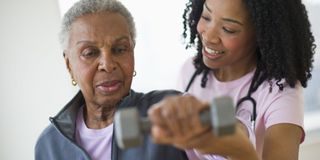Exercising with Parkinson’s disease

Consider exercising with friends for added motivation.
What you need to know:
- It is important to note that there is no one best type of exercise for people with Parkinson’s disease. It is most important to choose an exercise regimen that you enjoy, and will continue to do.
While medication is crucial in managing ailments, exercising plays a major role in reducing the impact of the disease on an individual. That is true even for a greatly debilitating condition such as Parkinson’s disease.
According mayoclinic.com, Parkinson’s disease is a progressive nervous system disorder that affects movement. Its symptoms start gradually, sometimes starting with a barely noticeable tremor in just one hand. Therefore, tremors are common, but the disorder also commonly causes stiffness or slow movement.
Augustine Kasujja, a fitness trainer, says when a person suffering from Parkinson’s disease starts exercising, their quality of life as well as their mental health and general well-being improve.
“Because the ailment comes with limited movement and stiffness, exercising will definitely better mobility and allow the patient to perform more motions, which makes daily activities easier,” he says.
Monica Nakyejwe, a fitness coach, says it is important to take a few minutes every day to do some movements. As such, engaging in workouts that better flexibility, cardio health and strength is crucial. As they do these exercises rotationally on a weekly basis, she says, the body will be empowered to learn ways to move.
Strengthening exercises: These include using weights, or resistance bands to better muscle strength.
Aerobic: This encompasses activities that allow the heart to pump more. They include stationary cycling, swimming, no-contact boxing, and brisk walking.
Balance: With movement abilities wanting, enrolling for dance, and Zumba will help the patient become firmer. Some activities can also be done with the help of a trainer and these work well to help a beginner.
Aerobics
Kasujja says aerobic workouts are meant to raise one’s heartbeat which ultimately betters heart health as well as lung function. These improve mobility, flexibility and build one’s strength while helping them to burn calories. One of the workouts is no-contact boxing which also betters hand-eye coordination. Kasujja says the patient needs a trainer to start and one of the activities is jab punches.
To get it done, they must stand with their feet under their hips or wider at shoulder width.
“Make fists and place them in front of your shoulders then punch with the right fist. Ensure that you extend your arm out fully before returning to the beginning position. Thereafter, punch out with the left fist. Do 20 repetitions for both sides in one set. With improved fitness, you can move to two sets in one go,” he says.
Many other of such exercises can be done depending on one’s fitness level, which Kasujja says can improve with continuous exercise.
Strength training
Nakyejwe says these are meant to build muscle and better one’s strength, which ultimately betters how they perform daily activities.
“It is better that the patient focuses on one muscle group at a time while alternating with time. This allows some muscle group to rest while others get worked on. Additionally, the muscle group also repair and become stronger, hence reducing injury risk,” she says.
Wrist curls: Nakyejwe says with weights, wrists can also be trained to not only better strength training but also grip strength. Wrist curls also reduce tremors, and better hand and finger dexterity, she says.
To get these done, get a weight; half kilogramme to three kilogramme and over a table or bench, hold it in one hand. It could be in your right or left hand, depending on your preference and keep the palm facing upwards. Then slowly move your wrist upwards as far as possible and maintain the position for a few seconds. Do this 12 times in sets of one for starters before moving to more sets. Switch to the other hand and do the same. Other strength training workouts include bicep curls, leg presses, and squats.
“Which ever of these exercises you choose, look at doing it 10 to 15 times beginning with one set moving to three sets as the fitness levels improve. Additionally, each muscle should be worked on two to three times every week with rest in between,” she says.
Balance
Kasujja says these are also called occupational workouts because they are aimed at ensuring you can do most things with ease. It is important to work with a trainer when doing these because they call for creativity and must be tailored to the patient’s needs.
One of these workouts is the one-leg stand workout which Kasujja says will help better your ability to walk, stand better as well as improving your confidence. To do this exercise, one needs support, which could be a wall or the back of a chair.
Rest your hands on your support of choice and place your weight on the leg with less strength while lifting up the other. Maintain this position for 10 to 20 seconds then return to your starting position. Do the same for the other leg and do the workout for 10 repetitions for one to two cycles, depending on your fitness level.
Tips and takeaways
● Consult your doctor before starting any exercise regimen.
● Consider physical therapy as a first step in getting your exercise regimen safely underway. Choose a physical therapist who has expertise in Parkinson’s.
● Choose exercise modalities that you will enjoy and stick with. Consider exercising with friends for added motivation.
● Aerobic, strengthening, balance and stretching are very important elements of exercise for people with PD. Try to incorporate all these elements into your weekly exercise.
● In addition, consider exercise in which you will learn a new motor skill as this can add potential cognitive benefits.





